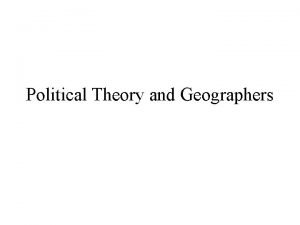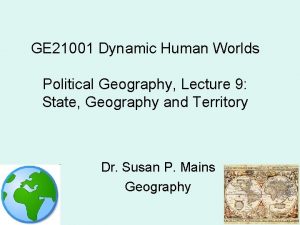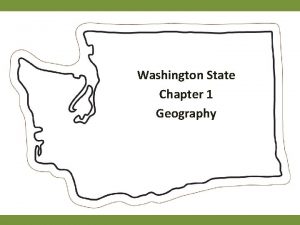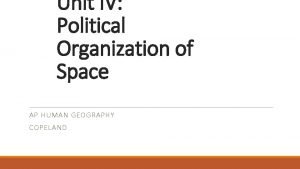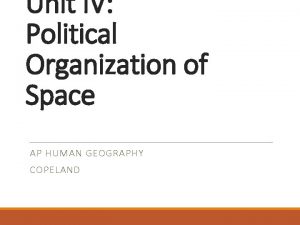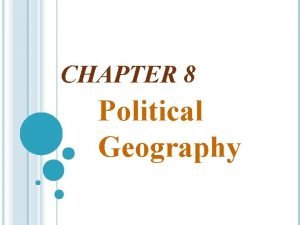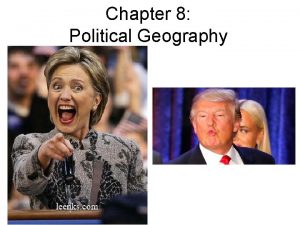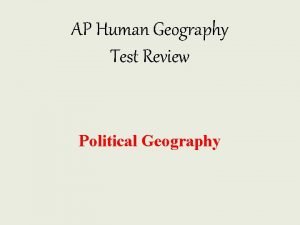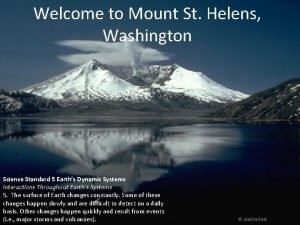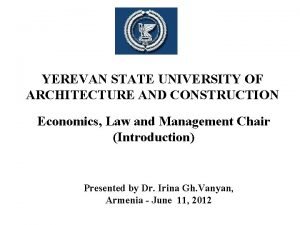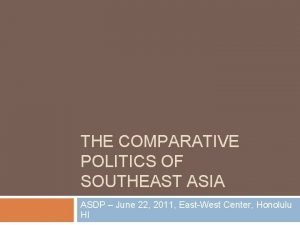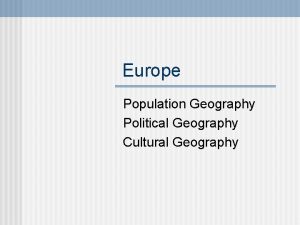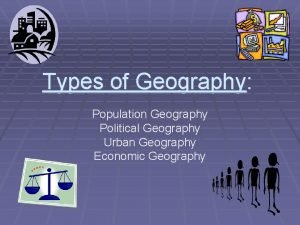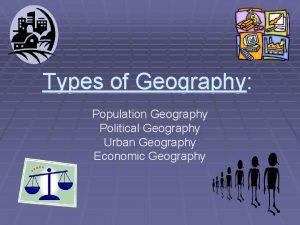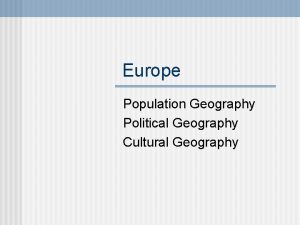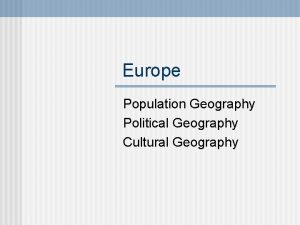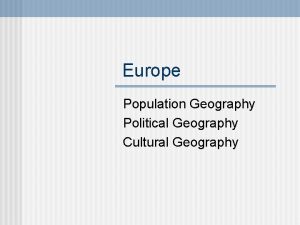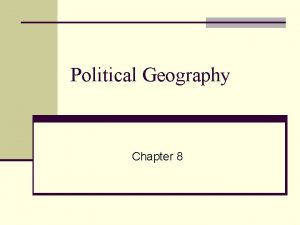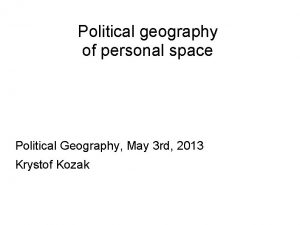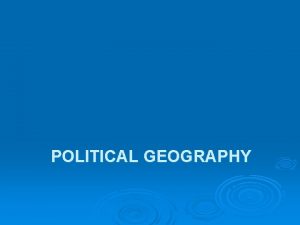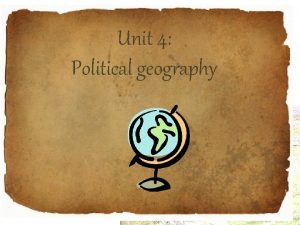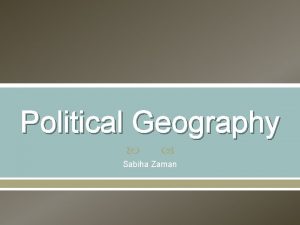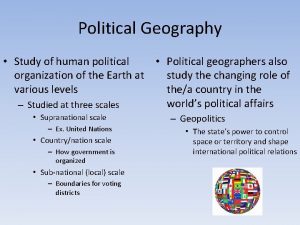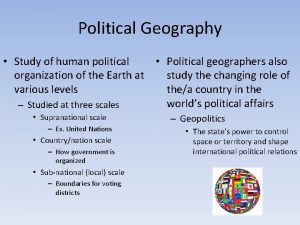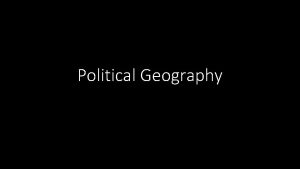Political Geography Political Architecture What is a State

































- Slides: 33

Political Geography

Political Architecture • What is a State? State = Population + Territory + Govenrment + Soverignty • “A state is a place, but is also a concept represented by certain symbols and demanding (though not always obtaining) the loyalty of people. ”

4 steps to becoming a state 1. Territory 2. Resident Population 3. Government that ensures sovereignty 4. Recognition by the international community

Political Architecture • What is a Nation-State? Nation + Territory + Government + Sovereignty • “A nation with a state wrapped around it…a nation with its own state, a state in which there is no significant group that is not part of the nation. ”

The Nation-State Triangle • Nation-states sit on a three-legged stool. Stability requires that each leg be strong and in place.

The Nation-State Triangle • Picture the stool as a triangle with the following vertices: Unified People Sovereignty Attachment to&control of Territory

Without all three legs the stool will fall!

Nation-State Triangles • Some entities on the world political map are sitting on a very un-stable two-legged stools: 1. Palestinians: A nation with a government, but not a state 2. Nigeria: A state with a government, but not a nation (not a national identity)

Nation-State Triangles 3. Somalia: A nation (Somalis) with a state, but no effective government (anarchy) 4. Iraq: A state divided among three nations: Sunni Kurds, Sunni Muslims, & the Shiite Muslims

• There are few “ideal” nationstates in the sense of being culturally homogeneous: 1. Iceland (language, ethnicity, history) 2. Denmark (language, ethnicity, history) 3. Japan (language, ethnicity, history, religion) 99. 5% of people are ethnic Japanese (Ainu or Ryukyans)

The World Political Map is a Lie! When we think of most states on the world political map as nation-states, we draw conclusions that may not be true: 1. We assume that people who live in Israel are Israelis. 2. We assume that people who live in Nigeria are Nigerians. 3. We assume that all Somalis live in Somalia. 4. We assume that people who live in Canada are Canadians. 5. We assume that all those in China are Chinese. 5. We assume that people who live in the United States are ______.

How was the world’s territory political organized by 2011? The building blocks of the world political map are: 192 UN Members 1. Independent states 193– Vatican City (countries or nation-states) 194 – Taiwan 2. Dependencies of independent states (colonies or protectorates) 3. Global commons (The high seas and Antarctica)

Let’s Review… Independent States • An independent state is a territorial entity occupied by a unified population…. you can find its boundaries on the map. The population need not be unified by culture! • An independent state has a government that has full authority over its internal and external affairs. • An independent state is sovereign and may be referred to as a sovereign state because it has full authority over its internal and external affairs.

Dependencies (or colonies? ) • Dependencies are external possessions of the world’s independent states. We used to call them “colonies” or “protectorates”. The most general term today might be “territories” 1. The largest in land area is Greenland, a selfgoverning possession of Denmark. It is the world’s largest island, but it has only 56, 000 people. Its official name is Kalaallit Nunaat 2. The largest in population is Puerto Rico, a possession of the United States. It is an island in the Caribbean Sea and has almost 4 million people.

Global Commons 1. Oceans The “High Seas” beyond the 12 -mile territorial limits of coastal states and the “International Seabed” beyond 200 miles. No state owns the open ocean It is governed under the rules laid down in the UN Convention on the Law of the Sea (1973 -82)

Global Commons 2. Antarctica. Although the political map of Antarctica looks like a pie cut into many wedges, these zones are simply “territorial claims. ” • Under the Antarctica Treaty (1959), no state owns any part of Antarctica; all states have the right to conduct scientific research there. • The US recognizes NO territorial claims to Antarctica and has none of its own. • The US does have research stations in Antarctica.

The world’s largest countries: 1. Russia – 6. 6 million sq. mi. – 2 continents 11. 5% of land – 11 time zones (out of 24) 2. Canada 3. China 4. United States 5. Brazil 6. Australia 7. India 8. Argentina 9. Kazakhstan 10. Sudan

The world’s smallest countries: 1. Vatican City (109 acres) 2. Monaco (368 acres) 3. Nauru (8 sq. mi. ) 4. Tuvalu (10 sq. mi. ) 5. San Marino (23 sq. mi. ) 6. Liechtenstein (61 sq. mi. ) 7. Marshall Islands (70 sq. mi. ) 8. St. Kitts & Nevis (104 sq. mi. ) 9. Maldives (115 sq. mi. ) 10. Malta (122 sq. mi) ______________ City of Virginia Beach 248 sq. mi. City of Richmond 60 sq. mi.

Large State Advantages Disadvantages Large Population Difficult to Unify Population More talent More culturally diverse Large Army Transportation More Natural Resources difficult Economic Self-sufficiency

Small State Advantages Disadvantages Easier to Unify population Small Population Less Talent Homogeneous Population Small defense force Less culturally diverse Vulnerable to Attack Transportation easy Fewer Natural Closer together Resources Economic vulnerability

Changing World Map • Today’s world political map is much different than it was 100 years ago, 200 years ago etc. • City-states developed slowly (beginning in the Fertile Crescent) and often attacked each other to form empires. • States that exist today began forming after the middle ages as areas of people of common cultural backgrounds joined together to form governments.

Changing World Map • In 1900–the British King & the Russian Czar alone controlled 1/3 rd of the land on earth. • You also had the French, Austro. Hungarian, German, Dutch, Danish, Belgian, Italian, American, Ottoman, Chinese, Japanese, Portuguese, and Spanish Colonial Empires

Colonialism v. Imperialism • A colony is a territory tied to an independent state and occupied by its citizens……therefor colonialism is simply an extension of a state. • Imperialism is the control of a territory that was previously occupied by and organized by an indigenous population. • There is a fine line between the two!!!!!

Changing World Map • How will the world’s territory be politically organized in 2100? • Some countries are coming together – European Union, NAFTA, etc. • Some countries are breaking apart – East Timor (2002), Montenegro (2006), South Sudan(2011) etc. We will talk about this more…later!!!

SIZE & SHAPE OF STATES • Every independent state on the world political map has a size and a shape: • The size and shape of a state may encourage either unity or division • Size: quantitative data, measured in square miles or square kilometers • Shape: qualitative data, measured according to how much it looks like a known shape or geometric form Do you see the shapes…or do you see the word…or both? ? ?

SHAPE Compact • circular to hexagonal • Uruguay, Poland, Switzerland • Communication and transportation are relatively easy in a compact country, as is the mobilization of the military. • A disadvantage is a lack of natural resources b/c compact countries tend to be smaller in size

SHAPE Elongated • Long, usually skinny • Nepal, Italy, Vietnam, & Chile • Distance can cause problems with the Transportation of raw materials to industrial centers. • Those living in the ends of the countries can feel isolated, which can lead to separatist movements.

Prorupt SHAPE • with a panhandle – appendage attached to main territory • Thailand, Namibia, Mexico, India, Florida is a proruption from the US. • One advantage of having a proruption is that it usually provides the country with access to a useful raw material. It may also provide trade opportunities. • The disadvantage is that the proruptions are usually fiercely fought over. • Proruptions are usually the doings of colonial powers and therefore, hard to justify. Caprivi Strip

SHAPE Fragmented • several non-continuous pieces • Indonesia (13, 000 islands 3, 000 miles), USA, Russia • A fragmented country is in pieces that are not attached to each other. Usually islands. • USA – when it added Alaska and Hawaii in 1959. • Alaska is an exclave – an area separated from its state by another state. • Kaliningrad is an exclave of Russia – separated by Latvia, Lithuania, and Belarus from Russia

SHAPE • Advantages to being fragmented? ? ? • The advantage of being fragmented is that another country would have a hard time trying to occupy and control your country. • For example, invading Indonesia would involve invading thousands of separate islands. • However, communications and the transportation between the separated areas can be difficult, especially if another country is in the way.

Perforated SHAPE • with a hole • South Africa (Lesotho) Italy (Vatican City & San Marino) • Lesotho, Vatican city are called enclaves – a country that is completely surrounded by another political state. They are always landlocked countries with no access to the sea.

• The advantage to having a country completely within your borders is that the ethnic group of the enclave has its own state. • If those people were part of the perforated country, there might be tensions. • The disadvantage of having a country completely within your borders is that it may get in the way of transportation and communication.

What about landlocked states? • With no direct outlet to the sea international trade is limited and cooperation with neighbors is crucial!
 How to write an frq for ap human geography
How to write an frq for ap human geography Stateless nation
Stateless nation 5 themes of geography ap human geography
5 themes of geography ap human geography Genetic boundary
Genetic boundary Objectives of political geography
Objectives of political geography Mariana trench
Mariana trench Relationship between political science and geography
Relationship between political science and geography Contemporary political map
Contemporary political map Anthropographic boundary definition
Anthropographic boundary definition Compare geometric boundaries and antecedent boundaries.
Compare geometric boundaries and antecedent boundaries. Political geography
Political geography Centripetal vs centrifugal
Centripetal vs centrifugal Postmodern architecture ap human geography
Postmodern architecture ap human geography Washington state geography
Washington state geography Examples of a compact state
Examples of a compact state Examples of locational boundary disputes
Examples of locational boundary disputes Perforated state ap human geography
Perforated state ap human geography Antecedent boundary example
Antecedent boundary example Centripetal forces ap human geography
Centripetal forces ap human geography Syncretism ap human geography definition
Syncretism ap human geography definition Geography washington state
Geography washington state What is architecture business cycle?
What is architecture business cycle? Call and return architecture in software engineering
Call and return architecture in software engineering Product architecture example
Product architecture example Integral architecture example
Integral architecture example Bus design in computer architecture
Bus design in computer architecture Yerevan state university of architecture and construction
Yerevan state university of architecture and construction Target state architecture
Target state architecture Instruction cycle in computer architecture
Instruction cycle in computer architecture Enterprise architecture vision statement example
Enterprise architecture vision statement example Do
Do State to state regionalism
State to state regionalism Synchronous counter design
Synchronous counter design Transition bugs in software testing
Transition bugs in software testing



